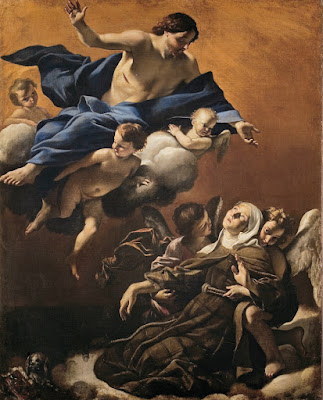 |
| Giovanni Lanfranco Assumption of the Virgin 1625-27 cupola fresco Basilica di Sant'Andrea della Valle, Rome |
 |
| Giovanni Lanfranco Ecstasy of St Margaret of Cortona 1622 oil on canvas Palazzo Pitti, Florence |
 |
| Giovanni Lanfranco The Last Supper ca. 1624-25 oil on canvas National Gallery of Ireland, Dublin |
 |
| Giovanni Lanfranco Paradiso 1643 cupola fresco Duomo di Napoli |
 |
| Giovanni Lanfranco Paradiso (detail) 1643 cupola fresco Duomo di Napoli |
 |
| Giovanni Lanfranco Paradiso (detail) 1643 cupola fresco Duomo di Napoli |
 |
| Giovanni Lanfranco Norandino and Lucina discovered by the Ogre (scene from Orlando Furioso by Ludovico Ariosto) ca. 1624 oil on canvas Galleria Borghese, Rome |
 |
| Giovanni Lanfranco Rinaldo abandoning Armida (scene from Gerusalemme Liberata by Torquato Tasso) 1614 oil on canvas private collection |
 |
| Giovanni Lanfranco Council of the Gods 1624-25 ceiling fresco Galleria Borghese, Rome |
 |
| Giovanni Lanfranco Council of the Gods Venus and Mars 1624-25 ceiling fresco Galleria Borghese, Rome |
 |
| Giovanni Lanfranco Staging of a Water Battle with Gladiators ca. 1635 oil on canvas Museo del Prado, Madrid |
 |
| Giovanni Lanfranco Virgin and Child appearing to St James the Greater and St Anthony Abbot 1622-23 oil on canvas Kunsthistorisches Museum, Vienna |
 |
| Giovanni Lanfranco St Augustine washing the Feet of Christ 1636 oil on canvas Iglesia de las Agustinas Recoletas, Salamanca |
 |
| Giovanni Lanfranco Rebecca and Eliezer at the Well before 1647 oil on canvas Galleria Sabauda, Turin |
 |
| Giovanni Lanfranco Self Portrait ca. 1628-32 oil on canvas Columbus Museum of Art, Ohio |
Giovanni Lanfranco (1582-1647) - Painter from Parma, he introduced to Rome the illusionism of Correggio's domes, initiating a new phase of Baroque decoration (1625-27, S. Andrea della Valle). During 1634-46 he was the most successful fresco painter in Naples, influencing later Neapolitan decorative painters, notably Luca Giordano. A pupil of Agostino Carracci, after his master's death in 1602 Lanfranco joined Agostino's brother Annibale in the service of the Farnese in Rome. Despite rivalry with Annibale's pupils and followers, notably Guercino, Reni and Domenichino – which caused him to retire back to Emilia, 1609-11 – Lanfranco was able to establish himself as one of the leading painters of successive papal courts and powerful aristocratic patrons, modifying the classicizing style of the Carracci school through an admixture of Caravaggesque chiaroscuro and the freer, more painterly mode of Correggio. The prelude to his great dome painting at S. Andrea was the loggia vault of the Villa Borghese, 1624-25, a more dynamic and freer critique of Annibale's Farnese Gallery ceiling. His move to Naples was motivated, however, by his eclipse in the 1630s by the artists of the Barberini court, Bernini and Pietro da Cortona.
– excerpted from the Yale Dictionary of Art and Artists, Erika Langmuir and Norbert Lynton (2000)